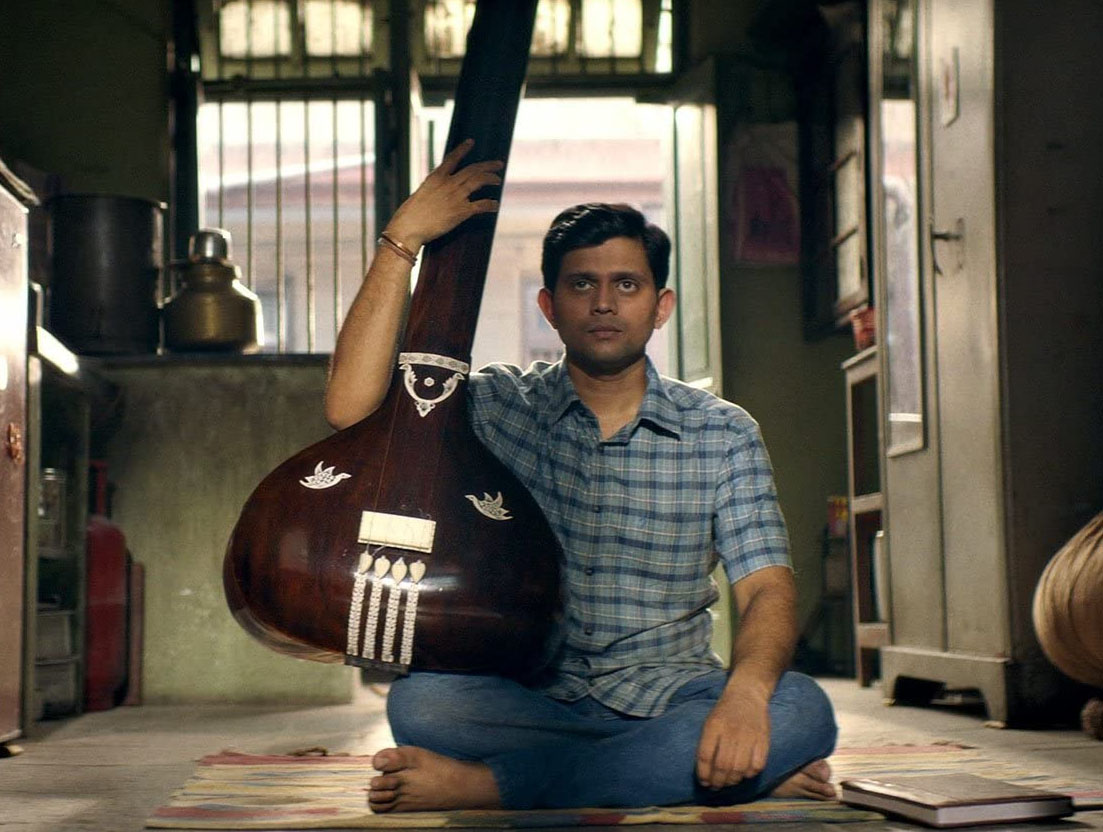There’s a recurring scene in “The Disciple” that presents a critical window into its desolate world. Sharad, a young man, rides through the dark and quiet city of Mumbai on his motorcycle. He has devoted his life, and every fibre of his existence, to becoming an Indian classical vocalist. As he rides, he listens to some lectures from Maai, a famed classic music guru.
Michal Sobocinski’s camera follows him as he rides, and it seems almost as if he is travelling in slow motion. The camera is not tender, but instead approaches Sharad with an undertone of uneasiness. As he rides, Maai’s words drone on. They seem to be both a directive and a warning, extolling on the commitment needed to truly succeed in this centuries’ long tradition. There is no joy in these words. Instead, her words feel dispassionate and as he rides Sharad, face stoic, listens alone on his motorcycle slowly moving forward.
It’s an important metaphor.
“The Disciple” is a film of overwhelming loneliness, but not in the ways you anticipate. Art about artists often venture into the ways creating can lead one to a life of isolation. To create is to be alone with one’s creation. But those explorations are almost always tinged with the awareness of the ways one’s work can touch others. In “The Disciple,” Chaitanya Tamhane’s sophomore feature, the exploration is about the loneliness of the pursuit. It is a story about a man without the talent to become a great artist, fated to a life of mediocrity – forever in pursuit, but never able to grasp anything resembling success.
It’s an incredibly precise focus for an artform that’s rarely represented in contemporary popular media. The North Indian classical music that forms the fulcrum of the story, also known as Hindustani music, is part of a tradition of Indian music that sometimes feel out of place amidst the hustle and bustle of modern life. Sharad’s devotion to it is built into his devotion to his guru Guruji, an ageing musician that Sharad depends on for guidance but who increasingly depends on Sharad for basic menial tasks.
Sharad’s deference to Guruji is bound to his belief that from his guru he can attain the critical skill of khayal – a central skill of the form where the singer improvises a performance from a built-in framework. This performance depends on a wealth of imagination. But, for all his devotion, Sharad’s dogged pursuit of success is more effortful than natural. He is all thinking with little feeling, and even less imagination. His desire cannot sustain him. And so we follow him through his life struggling to reach that goal.
The recurring evening drives, listening to Maai, at first felt like a symbol of devotion. But which each repeated night-time journey, the dispassionate advice begins to feel more and more like a curse – fating Sharad to a life that can never bring him joy.
Newcomer Aditya Modak is the film’s secret weapon. He wears Sharad’s longing on every part of his body, and in the first half of the film we believe in his naiveté enough to feel convinced by that desire. But midway through the film there’s a decisive time-jump when the hope of youth gives way to the hollow reality of an older, more bitter Sharad.
As “The Disciple” continues, the passage of time becomes a window into the philosophical viewpoint of Tamhane, who writes and directs. Like the music that defines it, “The Disciple” rewards patience – but there is no devotion to the abstruse here. Instead, the patience that the film rewards is borne out of an especially tender engagement with Sharad’s psychological viewpoint. As we watch Sharad slowly coming to grips with his reality, the film becomes a sharp and overwhelming character of a man struggling to find a purpose in a purposeless world.
With that, “The Disciple” becomes a filmic representation of contemporary loneliness that cuts through cultures and times. Tamhane’s preoccupation with the sense of isolation becomes the strongest arc in “The Disciple”, mournful but poignant. Tamahne is masterful at evoking mood and getting into the exact headspace of what it feels like to feel truly alone. He finds dramatic tension in the most banal of incidents, understanding the nuance of Sharad’s psychosis.
In a scene in the second half, we watch Sharad reading online comments on YouTube of an underwhelming performance of his. The moment manages to avoid being cringe or kitsch, and instead evokes a sad nobility. “The Disciple” rewards attention but it comes less from a focus on being hard to understand and more of an extension of Sharad’s own ambivalent diffidence.
By the end we come recognise that the film is manifesting a mournful tone for the man at its centre. And as the past dissolves into the present and then into a nebulous future, “The Disciple” reveals itself as a film preoccupied with the idea of time. Sharad is a man out of place, and out of time.
There are two scenes, late in the film, that emphasise this. The first is a meeting with a music critic that disrupts his idea of his idols. The second is a casual glance at the television as an American Idol style show displays the musical stars of India. During both moments a knowing realisation plays across Modak’s face. Some-thing like sadness, something like regret. But also, something like relief. To be forever in pursuit of greatness is a loneliness business. Even he is not sure how much it’s worth. It’s an unusual ideology for a film by a filmmaker so in tune with artistic inclinations, but it’s the surest sign of Tamhane’s own clarity of purpose. The complicated themes of “The Disciple” will linger for a long time after the last strains of Shahad’s singing fade.
The Disciple premiered on April 30 on Netflix.







